by The Curious Scribbler
Early last month I lamented the loss of the shrub planting below the Hugh Owen building. Never have I had so many readers, 1600 within 24 hours of posting, and the cries of anguish echoed far and wide. But the destruction continues. Gardening, according to the Aberystwyth Estates Department, is an activity best performed with a mechanical digger.
In the last two weeks whole shrub borders have scraped from the ground. Adjoining the Student Welcome Centre were three trees, two phyllyrea and a griselinia, and a border of hydrangea, fuchsia, escallonia and evergreen olearia species. Now only the trees remain. The border has been grubbed out entirely. Viewed from the Llandinam concourse there is little to see now, but an unkempt lawn with a circular bed containing a dead tree, and, beyond it, a large green painted metal box.
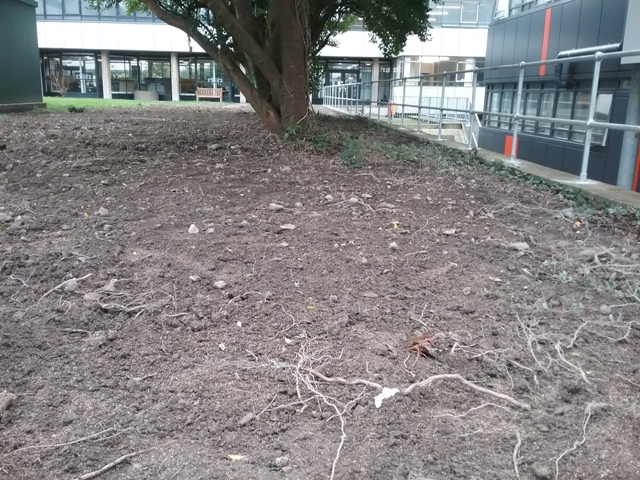
Recently uprooted border at the Penglais campus
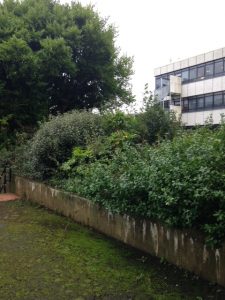
The border on 7 October before its destruction
The border needed some weeding and maintenance it is true, but it formed a handsome screen at the top of a concrete retaining wall outside the Llandinam building concourse.
Where the steps lead down towards the Cledwyn building, a broad swathe of ground hugging cotoneaster and vinca on either side of the descent was badly invaded by brambles. A gardener might have dug these out, or cut them and poisoned the stumps. Instead a few hours with a digger have obliterated the lot, and the bramble roots will be the first to recover in the broken earth.
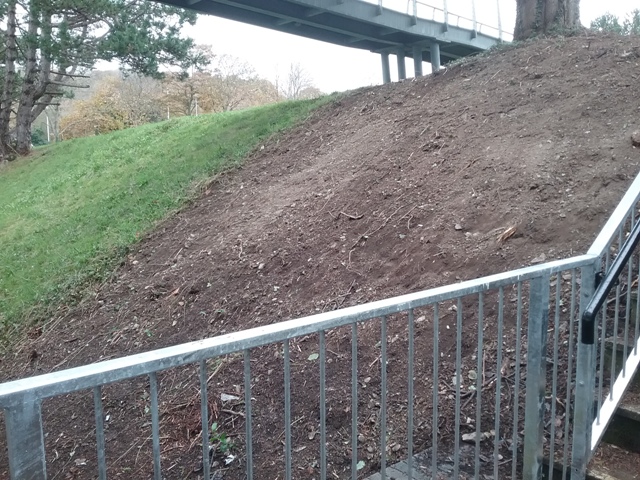
Formerly a bank clothed in prostrate and low growing cotoneaster?
Further down, the iconic view of the terracotta-coloured end of the Physical Sciences building is framed by some freshly mangled trees, chopped off at some 8 feet above ground.
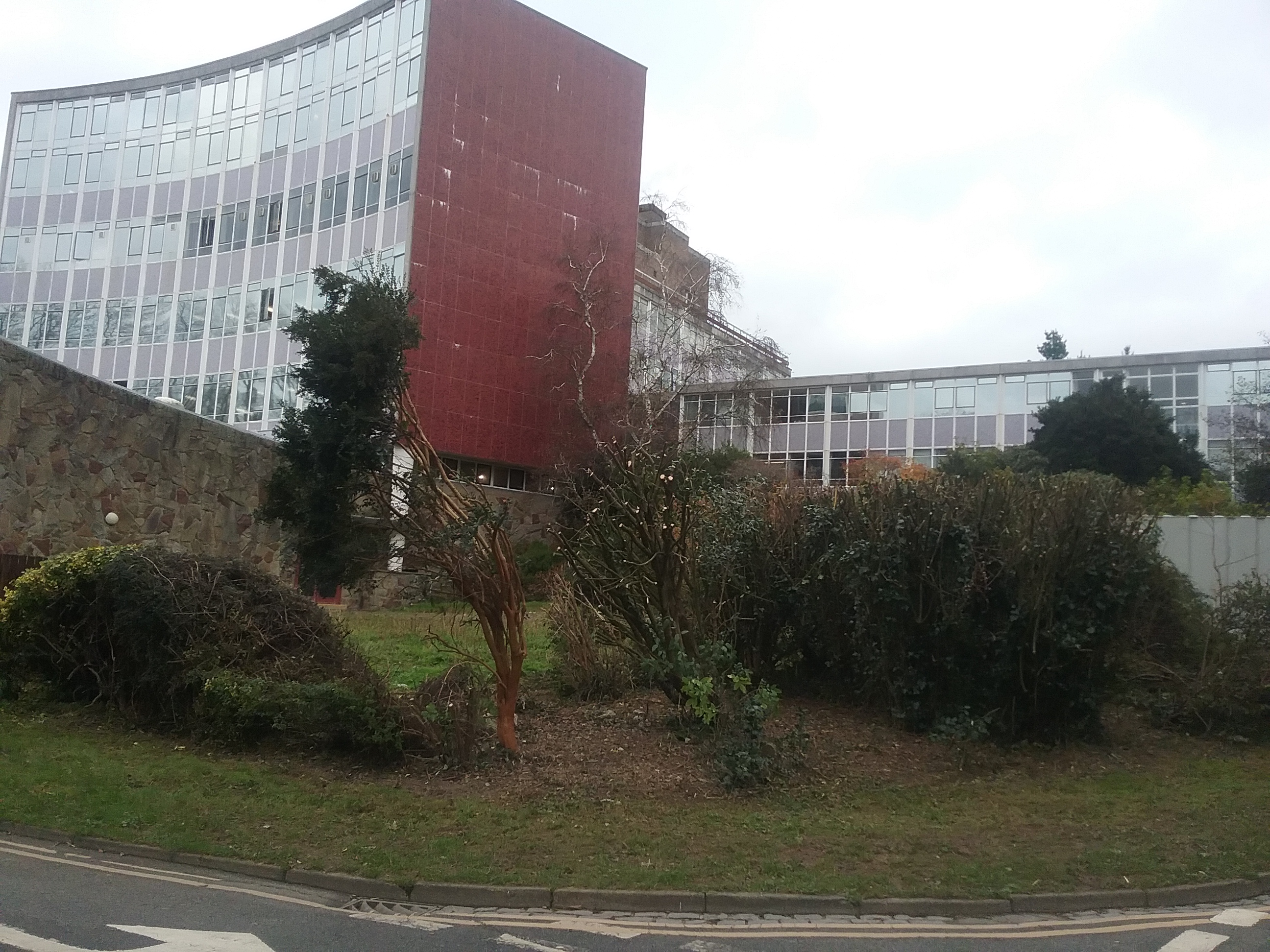
Crude pruning of a group of mature shrubs
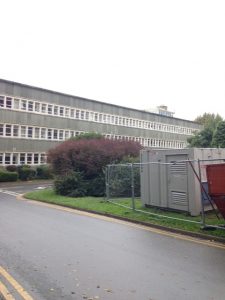
Border on the corner between Biology and Physics on 7 October
A distorted, one-sided Myrtle, Luma apiculata reaching over to the left (one of many seedlings on the campus), echoes the space formerly occupied by a large cotoneaster and a purple berberis beside it. This was all looking quite tidy as a group at the beginning of the month, though it adjoined a building site. Now the designed planting has been hacked away, and the accidental incomer has been preserved. It was the same below the Hugh Owen, where randomly spared trees include self seeded willow and ash.
There is some fine planting further up the slope on the terrace leading to the Physics entrance. I wonder whether that will survive.
The triangular bed at the west end of the Biology building used to contain big evergreen daisy bushes Olearia avicenniifolia. This tender New Zealand species first came to Tresco in the Scilly islands in 1914 and according to the RHS Plantfinder is available at just one nursery in the UK today. It’s gone. But we get a marvellously unimpeded view of the connecting glass corridor which seems function principally as a box store.
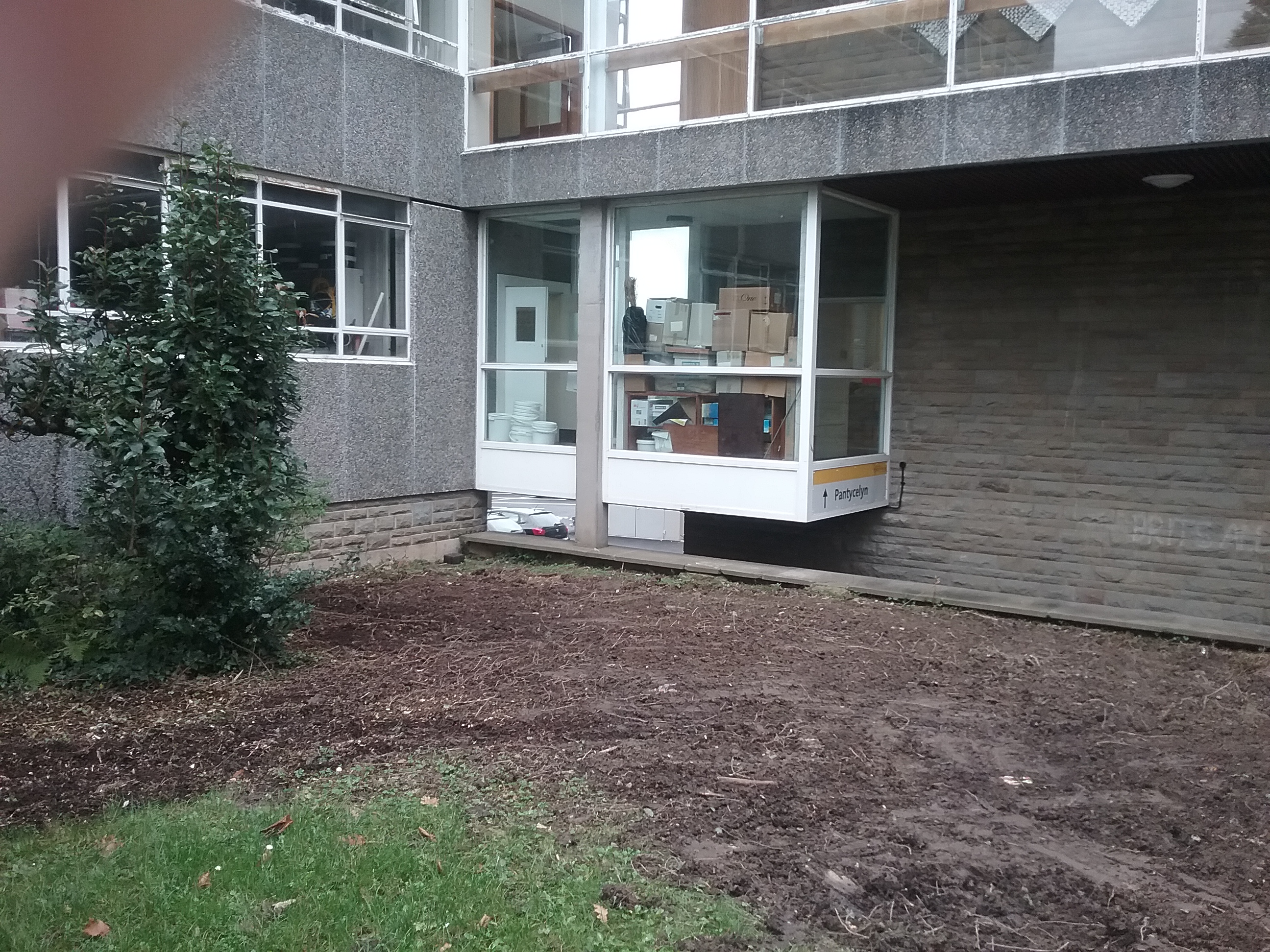
One of the uglier features of the Biology building is exposed to view
Adjoining the end of the building was a Crinodendron hookerianum, the Chilean Lantern Tree, approaching its mature height of 20 feet. This slow-growing narrow tree dangles fleshy crimson flowers about an inch long from summer till autumn. It has had its top cut off, though an adjoining dead tree cloaked in ivy has been spared.
Continuing down the road between the Sports building and Biological Sciences, the corner has been cleared to display a few stumps and a manhole cover. The metre-wide strip adjoining the road was cleared back a year ago and has been seeded with teasels and foxgloves which will look quite pretty next spring. Not for long though. Foxgloves are biennial, so the current crop will die next summer, and dock and creeping buttercup will take their place. Soon we can call this teasel corner.
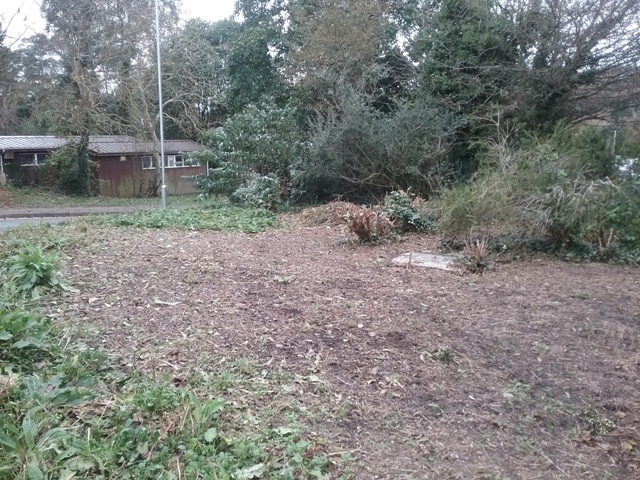
The corner between Biology and the the Sports Centre
There are shrubs on the campus so choice and rare that one would be hard pressed to find them anywhere else. As a random illustration I include a picture of one of the Australia acacias planted against the Biology building. It displays most elegant heterophylly. The long leathery Mistletoe-like leaves are born on the same stems as the feathery new growth. ( Students generally learn about heterophylly by studying water crowfoot. How much more magnificent in a tree!)
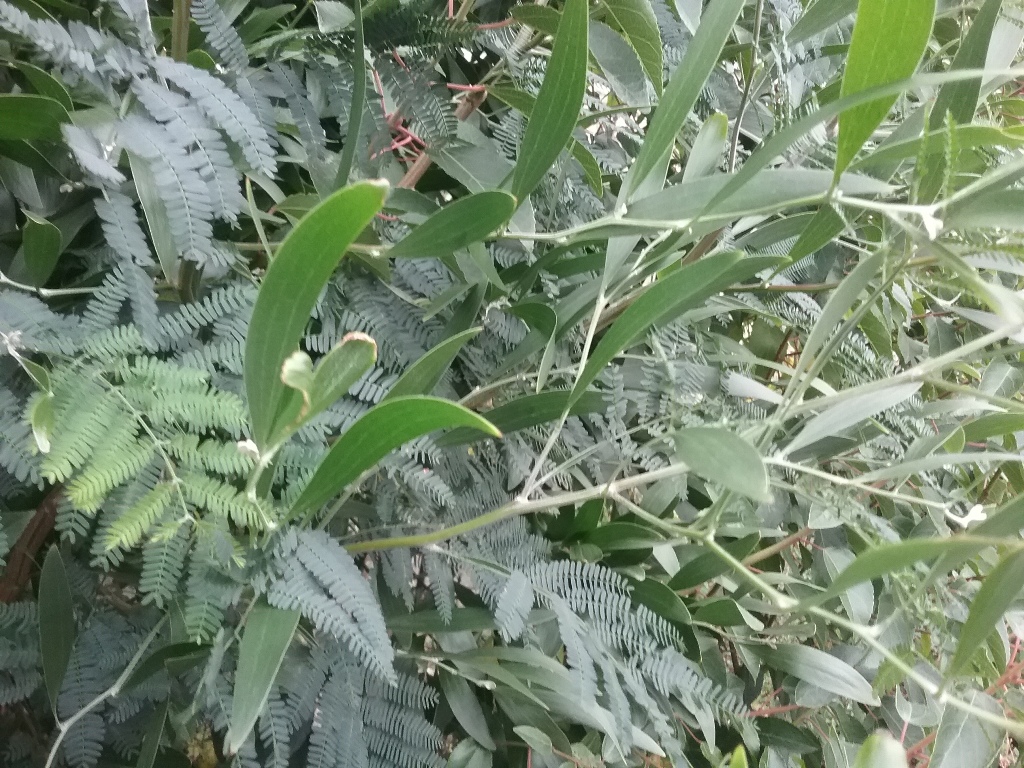
Heterophylly in an Australian acacia
The hackers and diggers may be there soon too, destroying more botanical heritage. There is also a Hoheria sexstylosa nearby, a rare Berberis and another rare daisy bush Olearia rotundifolia flourishing far from its native habitat the southern alps of South Island, New Zealand. The list could go on. But no-one making the decisions about the contractors’ actions seems to know or care about plants. I doubt any future planting will be more than commonplace.
My final picture is of one of the recently completed works. An extensive border was removed and bark chippings laid to frame these unattractive pipes and utility sheds beside an arterial path to the Student Welcome Centre.
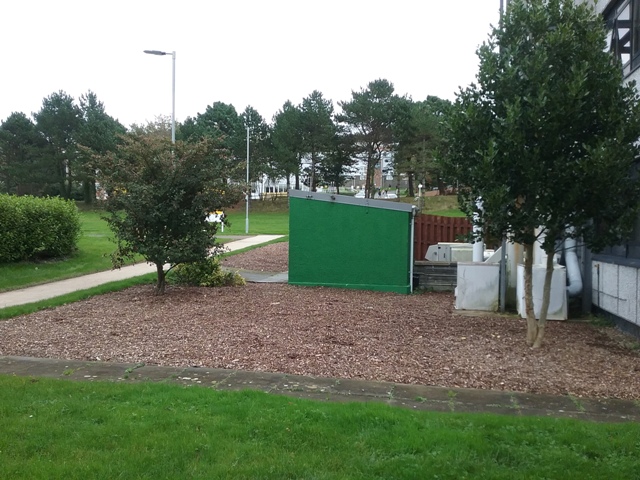
The future gardening style for the Aberystwyth University campus
The is not the style for which the gardens were listed Grade II* by Cadw just fifteen years ago.

Oh dear, my late father would be so angry, he was an avid botanist and physicist in the uni back in the 1960’s. Such a shame that with a bit more thought a bit of thoughtful and careful clearing would have saved these plants and trees . I wonder what’s going in their place , a load of concrete??
I’m sure Professor Wareing and Basil Fox would be very sad to see what’s happening to the campus they took such great care over.
So very sad!
Well apparently there is a plan: https://www.aber.ac.uk/en/news/archive/2017/10/title-207442-en.html
As a member of staff I cannot recall being consulted on the plan, but it looks very good on the University website.
I believe the VC is soon to be taken on a guided tour of the Plas Gogerddan estate, another of the University’s heritage assets.
I understand this new working group has yet to meet and form a plan.
Sad to see this happening. Readers may be interested in the Cadw Parks and Gardens Register text description of University College Aberystwyth grounds; extract below & link to full description:
http://orapweb.rcahms.gov.uk/coflein//C/CPG164.pdf
“The whole campus is extensively and attractively landscaped with planting
that has been carefully chosen to complement the modern buildings, to suit the
sloping site, to tolerate the salt-laden air and to take advantage of the mild, seaside
location. Now that much of the planting is mature its remarkable effectiveness is
apparent. Planting has been used to screen buildings from one another, to enhance
buildings and their settings, to screen car parks and other utilitarian areas and
generally to create a very attractive environment. The density of planting is
remarkable; no corner is left unplanted, mainly with evergreen shrubs and conifers.
The foreground to many buildings is banks and mounds of greenery, both tall and
low-growing. The dominant tree species, mainly planted along the boundaries and
flanking drives, is the pine. A wide variety of shrubs is grown but characteristic
species include eleagnus, griselinia, ligustrum, hebe, heathers, olearia, phlomis,
berberis and escallonia. Mixed holly and beech hedges (as also seen at Plas Penglais)
are also characteristic”
From an alumni e-mail from the University a few days ago:
“The Welsh Historic Gardens Trust is working with Aberystwyth University in a new partnership to develop a long-term conservation plan for the Penglais campus grounds.
A joint working group has been set up with representatives from the Ceredigion branch of the Trust, with the first meeting held Monday 16 October 2017,
As well as the Trust, the group will include Estates Department staff and the University’s own botanical experts.
There will also be consultation with staff and students as part of the development of a conservation management plan for the grounds, which are Grade II* listed by Cadw.”
They go on to say:
“We are delighted that the Ceredigion branch of the Welsh Historic Gardens Trust will be working with us as we develop our new conservation management plan for Penglais campus as they bring with them a wealth of botanical and historical knowledge of this special site. Our range of discussions will include looking at what kind of planting could be used to replace areas where the plants were no longer viable or causing damage. We will also be drawing on the expertise of the University’s own botanical experts and consulting with staff and students as we promote best practice and ensure that our campus grounds remain an asset to be enjoyed by the community as a whole….A number of distinct areas of garden are covered by the Grade II* listed status. These include the plantings uphill of Pantycelyn designed by leading twentieth-century landscape architect Brenda Colvin in 1963; ground cover plantings from the 1970s around several buildings on Penglais campus, and the older garden at Plas Penglais. The Llanbadarn campus is also listed.”
Make of that what you will!
Pingback: Penglais Campus – the new Vision? | Letter from Aberystwyth